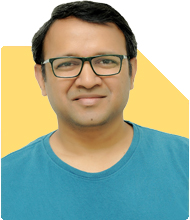Ramalingam Kalirajan |10899 Answers |Ask -Follow
Mutual Funds, Financial Planning Expert - Answered on Jun 05, 2024
He has an MBA in finance from the University of Madras and is a certified financial planner.
He is the director and chief financial planner at Holistic Investment, a Chennai-based firm that offers financial planning and wealth management advice.... more

Is FD a good option for a monthly income plan? I have Rs.1.5Cr in my PF
Fixed deposits (FDs) are a popular investment option in India. They offer stability and guaranteed returns. However, is an FD the right choice for generating a monthly income from your Rs.1.5 crore Provident Fund (PF)? Let's explore this in detail.
Stability and Safety
FDs are one of the safest investment options available. They are less volatile than stocks and mutual funds. Banks and post offices offer FDs with a guarantee on the principal amount. This makes FDs an attractive option for risk-averse investors.
In India, FDs are insured up to Rs.5 lakh per depositor per bank. This insurance provides an additional layer of safety. For someone looking to preserve capital, FDs are an excellent choice.
Predictable Returns
One of the biggest advantages of FDs is the predictability of returns. Unlike market-linked investments, FDs offer a fixed interest rate. You know exactly how much you will earn at the end of the tenure. This can be reassuring, especially in volatile market conditions.
Convenience
FDs are easy to manage. They do not require constant monitoring like stocks or mutual funds. Once you invest in an FD, you can sit back and relax. This is particularly beneficial for those who prefer a hands-off approach to investing.
Regular Interest Payouts
FDs offer various interest payout options, including monthly, quarterly, and annual payouts. For generating a regular monthly income, you can opt for the monthly payout option. This ensures a steady stream of income to meet your expenses.
Taxation on Interest Income
Interest earned on FDs is taxable. It is added to your total income and taxed as per your income tax slab. For someone in a higher tax bracket, this could significantly reduce the net returns.
Inflation Impact
While FDs offer guaranteed returns, they may not always keep pace with inflation. Over time, inflation can erode the purchasing power of your money. This is a crucial factor to consider, especially for long-term investments.
Assessing Alternatives: Actively Managed Funds
Actively managed funds can be a compelling alternative to FDs. These funds are managed by professional fund managers who actively make investment decisions to maximize returns.
Potential for Higher Returns
Actively managed funds have the potential to offer higher returns compared to FDs. This is because fund managers can capitalize on market opportunities.
Diversification
Actively managed funds invest in a diversified portfolio of assets. This helps spread risk and potentially enhances returns. Diversification can provide a cushion against market volatility.
Flexibility
Actively managed funds offer flexibility in terms of investment amount and redemption. You can start with a small amount and increase your investment over time. Additionally, you can redeem your investment partially or fully as per your needs.
Professional Management
These funds are managed by experienced professionals. Fund managers have the expertise to analyze market trends and make informed investment decisions. This can be advantageous for investors who lack the time or knowledge to manage their investments.
Tax Efficiency
Certain actively managed funds, such as equity mutual funds, offer tax benefits. Long-term capital gains from equity funds are taxed at a lower rate compared to FD interest. This can enhance your overall returns.
Regular Funds Through a Certified Financial Planner
Investing in regular funds through a certified financial planner (CFP) can be beneficial. A CFP can provide personalized advice based on your financial goals and risk appetite. They can help you choose the right funds and create a diversified portfolio.
Systematic Withdrawal Plans (SWPs) for Monthly Income
Systematic Withdrawal Plans (SWPs) are an effective way to generate regular monthly income from mutual funds. An SWP allows you to withdraw a fixed amount from your mutual fund investment at regular intervals, typically monthly. This can ensure a steady income stream while your investment continues to grow.
How SWPs Work
With an SWP, you invest a lump sum amount in a mutual fund. You then set up a plan to withdraw a fixed amount each month. This amount is credited to your bank account on a pre-specified date. The remaining investment continues to earn returns, providing the potential for capital appreciation.
Benefits of SWPs
Regular Income: SWPs provide a predictable and regular income stream, which is ideal for managing monthly expenses.
Tax Efficiency: Withdrawals from equity mutual funds are subject to capital gains tax, which can be more tax-efficient compared to the interest earned on FDs.
Capital Growth: While you withdraw a portion of your investment, the remaining amount continues to grow, offering the potential for long-term capital appreciation.
Flexibility: SWPs offer the flexibility to increase or decrease the withdrawal amount as per your needs. You can also stop the withdrawals if your financial situation changes.
Rupee Cost Averaging: By regularly withdrawing a fixed amount, you benefit from rupee cost averaging, which can reduce the impact of market volatility on your investment.
Setting Up an SWP
To set up an SWP, you need to follow these steps:
Choose a Mutual Fund: Select a mutual fund that aligns with your investment goals and risk tolerance. Equity mutual funds are often preferred for their potential for higher returns.
Invest Lump Sum: Invest a lump sum amount in the chosen mutual fund. Ensure the investment amount is substantial enough to support your monthly withdrawal needs.
Define Withdrawal Amount: Decide on the fixed amount you want to withdraw each month. Ensure this amount is sustainable based on your investment and expected returns.
Schedule Withdrawals: Set up the SWP with your mutual fund house, specifying the withdrawal amount and frequency (e.g., monthly).
Monitor and Adjust: Regularly review your SWP to ensure it meets your financial goals. Adjust the withdrawal amount if necessary to match your expenses and investment performance.
Balancing Risk and Return
While FDs offer safety, actively managed funds provide the potential for higher returns. It is essential to strike a balance between risk and return. You can allocate a portion of your funds to FDs for stability and the rest to actively managed funds for growth.
Creating a Diversified Portfolio
A diversified portfolio can provide a balance of safety, income, and growth. You can include a mix of FDs, actively managed funds, and other investment options. This approach can help mitigate risks and enhance returns.
Planning for Monthly Income
For generating a monthly income, you can consider a combination of FDs and Systematic Withdrawal Plans (SWPs) from mutual funds. SWPs allow you to withdraw a fixed amount from your mutual fund investment regularly. This can provide a steady stream of income.
Emergency Fund
It is crucial to set aside an emergency fund before investing. This fund should cover at least six months' worth of expenses. FDs can be a good option for an emergency fund due to their liquidity and safety.
Estate Planning
Consider estate planning to ensure a smooth transfer of assets to your heirs. Nominate beneficiaries for your FDs and mutual funds. This can help avoid legal hassles and ensure your loved ones are taken care of.
Regular Review and Rebalancing
Regularly review your investment portfolio to ensure it aligns with your financial goals. Rebalance your portfolio periodically to maintain the desired asset allocation. This can help manage risk and optimize returns.
Conclusion
FDs can be a good option for generating a stable monthly income. They offer safety, predictable returns, and convenience. However, they may not keep pace with inflation and the interest income is taxable.
Actively managed funds provide the potential for higher returns and diversification. Investing in these funds through a certified financial planner can enhance your overall investment strategy. Consider surrendering high-cost investment products like LIC, ULIP, and investment-cum-insurance policies and reinvesting in mutual funds for better returns.
Creating a diversified portfolio that includes FDs and mutual funds can provide a balance of stability and growth. Plan for a regular income through a combination of FDs and SWPs. Ensure you have an emergency fund in place and consider estate planning.
Regularly review and rebalance your portfolio to stay on track with your financial goals. By carefully evaluating your options and making informed decisions, you can achieve a stable and growing monthly income from your investments.
Best Regards,
K. Ramalingam, MBA, CFP,
Chief Financial Planner,
www.holisticinvestment.in
You may like to see similar questions and answers below
Omkeshwar Singh | Answer |Ask -Follow
Head, Rank MF - Answered on May 12, 2021
Sanjeev Govila | Answer |Ask -Follow
Financial Planner - Answered on Mar 01, 2023
Ramalingam Kalirajan |10899 Answers |Ask -Follow
Mutual Funds, Financial Planning Expert - Answered on May 23, 2024
Ramalingam Kalirajan |10899 Answers |Ask -Follow
Mutual Funds, Financial Planning Expert - Answered on May 27, 2024
Ramalingam Kalirajan |10899 Answers |Ask -Follow
Mutual Funds, Financial Planning Expert - Answered on Dec 17, 2025
Ramalingam Kalirajan |10899 Answers |Ask -Follow
Mutual Funds, Financial Planning Expert - Answered on Dec 17, 2025
Ramalingam Kalirajan |10899 Answers |Ask -Follow
Mutual Funds, Financial Planning Expert - Answered on Dec 17, 2025
Ramalingam Kalirajan |10899 Answers |Ask -Follow
Mutual Funds, Financial Planning Expert - Answered on Dec 17, 2025
Ramalingam Kalirajan |10899 Answers |Ask -Follow
Mutual Funds, Financial Planning Expert - Answered on Dec 17, 2025
Mayank Chandel |2576 Answers |Ask -Follow
IIT-JEE, NEET-UG, SAT, CLAT, CA, CS Exam Expert - Answered on Dec 17, 2025
Radheshyam Zanwar |6747 Answers |Ask -Follow
MHT-CET, IIT-JEE, NEET-UG Expert - Answered on Dec 16, 2025
Shalini Singh |181 Answers |Ask -Follow
Dating Coach - Answered on Dec 16, 2025
Patrick Dsouza |1429 Answers |Ask -Follow
CAT, XAT, CMAT, CET Expert - Answered on Dec 16, 2025
Nayagam P P |10858 Answers |Ask -Follow
Career Counsellor - Answered on Dec 16, 2025



























